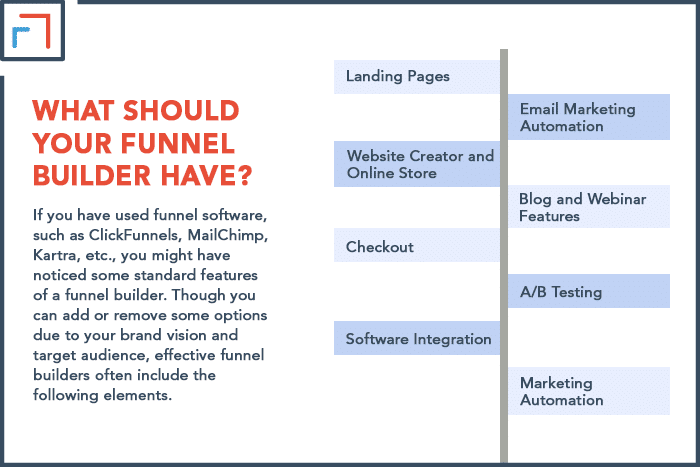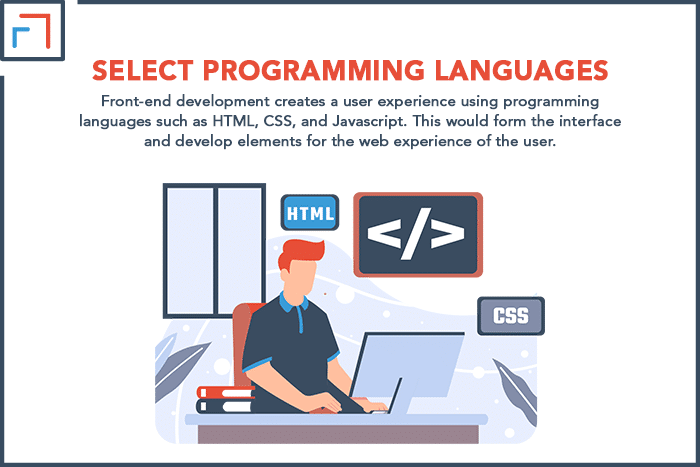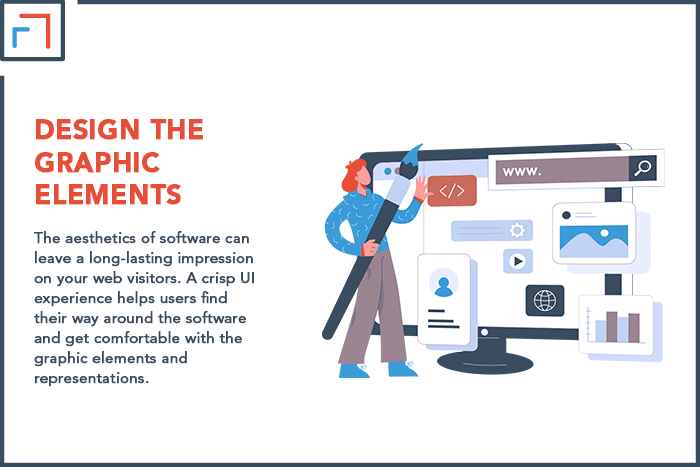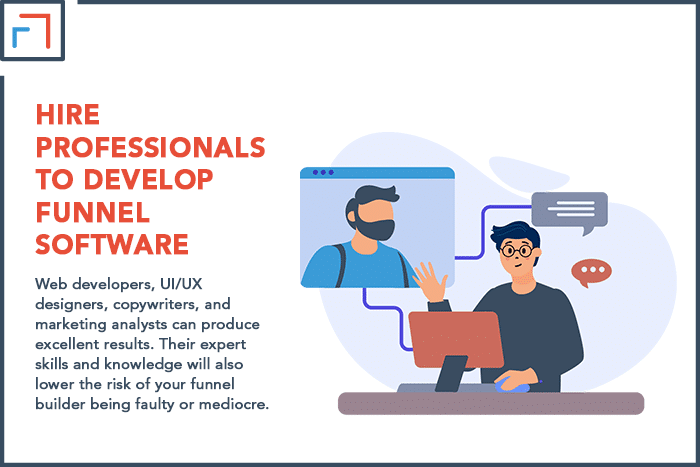If you’re impressed by how well funnel builders can deliver results, you might have considered making your own funnel builder. This is easier said than done because funnel builders need to include a lot of features and elements.
To make a funnel builder, you need to include tools for creating landing pages, allowing email automation, website hosting and development, content creation, checkout system, and A/B testing. You can create funnel builder software by combining web development, design, and copywriting.
Creating a funnel builder may be a long and complex process, but it is doable if you follow some basic steps. Keep reading to learn how to make your own funnel builder.
What Should Your Funnel Builder Have?
If you have used funnel software, such as ClickFunnels, MailChimp, Kartra, etc., you might have noticed some standard features of a funnel builder.
Though you can add or remove some options due to your brand vision and target audience, effective funnel builders often include the following elements.
1. Landing Pages
Effective sales funnels almost always include a landing page, so you need to have this element in your own builder.
Design different landing pages for motivating conversions, getting subscribers, setting up accounts, etc.
These web pages include a call to action which directs the incoming traffic according to your marketing strategy.
2. Email Marketing Automation
Staying in touch with leads will help increase your conversion rate. Automated email marketing will help increase brand awareness and develop customer relationships.
Your funnel builder could integrate with third-party email autoresponders, or you could create an internal tool for your software.
3. Website Creator and Online Store
If possible, your funnel builder should allow users to create and set up a website within the software.
This will help customers create a single central place to focus their marketing efforts.
You could also include an online store feature for products and services that users want to offer.
4. Blog and Webinar Features
Content creation generates traffic and strengthens your brand presence in the market.
Your funnel builder should offer tools to create, design, and upload blogs and webinars.
To make things easier for users, you might create pre-designed and customizable templates.
5. Checkout
Since this is the conversion stage, it should be a smooth experience. A secure, verified, and easy-to-use checkout system is vital to the user experience.
Your checkout process should ensure there are valid payments and an easy-to-follow process.
6. A/B Testing
By offering A/B testing, users can decrease their bounce rates while simultaneously generating valuable content.
In addition, the ability to test different versions of a page or element will help users refine their approach.
This functionality will also allow your software users to spot issues in the funnel process.
7. Software Integration
Compatibility is imperative because users might want to use external plugins for different features that may not be included in your software.
You can create a more efficient funnel builder by allowing software integration with third-party applications.
8. Marketing Automation
Automation (such as CRM and marketing analytics) allows users to achieve measurable results through a seamless process.
The less work they have to do, the easier it is to focus on other parts of the business.

Steps To Create A Funnel Builder
Creating a funnel builder needs a sequence of organized steps rather than a haphazard approach. Here’s how to go about it:
1. Analyze Market Trends
Before creating a marketing software, you must conduct an in-depth analysis of your market, trends, competitors, and, most importantly, your target audience.
Understanding your audience’s needs and desires will help you create a funnel builder that is best suited to the potential users.
Make sure you also research recent technological innovations that could be used in your funnel builder.
This would allow you to develop a unique niche where you could stand out from the competition.
Assess the current funnel builders that are popular in the market and evaluate their strengths and weaknesses.
By using your evaluation and secondary research of customer reviews and product comparisons, you can find a unique feature to offer to your consumer base.
2. Select Programming Languages
While creating various parts of your funnel builder, you will need to select different programming languages that are suitable for the functions you require.
Front-end development creates a user experience using programming languages such as HTML, CSS, and Javascript.
This would form the interface and develop elements for the web experience of the user.
As for back-end development, you could opt for Ruby or PHP, which would ensure that user requests are being fulfilled without error or delay.
For a funnel builder, you would also need to use an application server, such as Nginx.
Application servers assist with automation and authorization of transactions. They also process large amounts of user data on web pages.
For instance, ClickFunnels uses a cloud cluster to manage endless traffic without the software lagging or crashing.
You can also assess how other companies address this concern so you can choose the most compatible option for your funnel builder.
As a result, you can expect your funnel software to host numerous applications and operate without interruption.

3. Design The Graphic Elements
The aesthetics of software can leave a long-lasting impression on your web visitors.
A crisp UI experience helps users find their way around the software and get comfortable with the graphic elements and representations.
Though designs should be creative and engaging, they shouldn’t stray too far from the mainstream experiences of the user.
This way, your funnel builder can stand out without alienating customers.
Proper graphic design will improve your brand recognition and increase customer retention.
The UI design should help users interact with elements and navigate from one page to the next.

4. Create Effective and Targeted Copywriting
Use clear and relevant copy to communicate the value of your software. The wording should be compelling enough for potential users to try out the service.
With properly targeted copy, you can focus on relating the audience’s needs to what your funnel builder offers.
When they understand the direct benefits of your software’s features, users have an obvious incentive to test the service.
5. Hire Professionals To Develop Funnel Software
Although you can do many things without coding or designing skills, you will probably need to hire professionals to develop a funnel builder that can compete against others in the market.
Web developers, UI/UX designers, copywriters, and marketing analysts can produce excellent results.
Their expert skills and knowledge will also lower the risk of your funnel builder being faulty or mediocre.
This, in turn, will save you time and resources that could be useful in the future.

In Summary: Funnel Builder Essentials
You can explore the features and designs of existing funnel builders to gain insight and find inspiration for the unique software you want to create.
Your funnel builder will need a basic set of tools and features to help it compete with existing companies.
Using market research, you can find ways to distinguish your funnel builder.
Creating a funnel builder is a strategic and gradual process that requires some professional skills to deliver efficient software to your users.
Reach out to funnel designers and professionals if you need help during this process.
